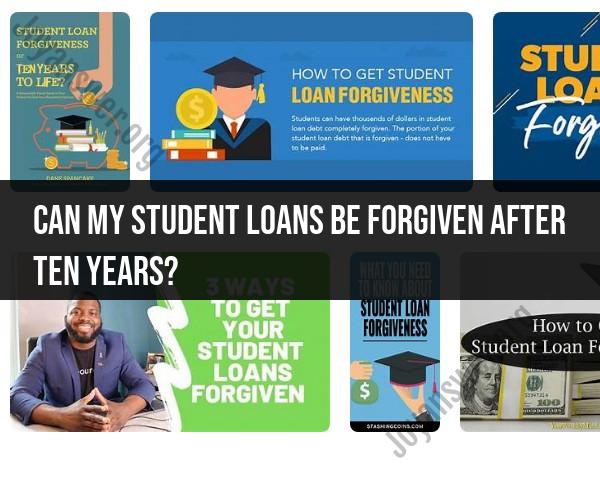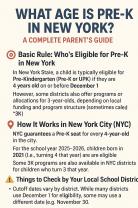Can my student loans be forgiven after ten years?
Yes, your student loans can potentially be forgiven after ten years under certain circumstances and specific student loan forgiveness programs. One of the most well-known programs that offers loan forgiveness after ten years is the Public Service Loan Forgiveness (PSLF) program. Here's how it works:
Public Service Loan Forgiveness (PSLF):
- To be eligible for PSLF, you must work full-time for a qualifying public service or nonprofit organization while making 120 qualifying payments. These payments don't have to be consecutive but must be made while working for a qualifying employer.
- After making 120 eligible payments (typically over ten years), you can apply for loan forgiveness.
- PSLF is available to borrowers with federal Direct Loans, and they must be on an income-driven repayment plan while making the 120 qualifying payments.
- The forgiven amount under PSLF is not subject to federal income tax.
It's important to note that not all student loans or repayment plans are eligible for PSLF. Private loans, FFEL (Federal Family Education Loan) Program loans, and some Direct Loan repayment plans are not eligible. Borrowers must also meet specific criteria related to their employment and repayment history to qualify for PSLF.
Additionally, other forgiveness programs and repayment plans may offer forgiveness or discharge after a longer period, such as 20 or 25 years, under different conditions. These programs, often based on income-driven repayment plans, may include Income-Based Repayment (IBR), Pay As You Earn (PAYE), and Revised Pay As You Earn (REPAYE).
To explore your options for student loan forgiveness after ten years or longer, you should:
- Review your loan types and determine whether they are eligible for forgiveness programs like PSLF.
- Understand the requirements of the specific forgiveness program you are interested in, including qualifying employment and repayment plan criteria.
- Consistently make on-time payments while meeting the program requirements.
- Keep records of your employment and payment history to document your eligibility.
It's advisable to consult with your loan servicer or a student loan expert to ensure that you are on the right track for loan forgiveness, as requirements and regulations may change, and individual circumstances can vary.
Student Loan Forgiveness: What You Need to Know
Student loan forgiveness is a program that helps borrowers repay their student loans. There are a number of different student loan forgiveness programs available, and each program has its own eligibility requirements and process.
Understanding the Public Service Loan Forgiveness (PSLF) Program
The Public Service Loan Forgiveness (PSLF) Program is a federal program that forgives the remaining balance of federal student loans for borrowers who have worked full-time for a qualifying public service employer for 10 years and made 120 qualifying monthly payments.
To be eligible for PSLF, borrowers must:
- Have federal direct loans.
- Work full-time for a qualifying public service employer.
- Make 120 qualifying monthly payments under an IDR plan.
Qualifying public service employers include:
- Federal, state, local, or tribal government agencies.
- Nonprofit organizations that provide public services.
- AmeriCorps or Peace Corps.
Borrowers who are interested in PSLF should apply for the program after making 120 qualifying monthly payments. Borrowers can use the PSLF Help Tool to determine if they are eligible for the program and to track their progress towards forgiveness.
Student Loan Forgiveness After Ten Years of Payments: Eligibility and Process
There is currently no federal program that forgives student loans after ten years of payments. However, there are some private student loan lenders that offer forgiveness programs.
To qualify for a private student loan forgiveness program, borrowers must typically meet certain requirements, such as:
- Having a good credit score.
- Making on-time payments for a certain period of time.
- Being employed in a certain field.
Borrowers who are interested in a private student loan forgiveness program should contact their lender to learn more about the program's eligibility requirements and process.
Alternatives to Loan Forgiveness: Repayment Plans and Options
If you are not eligible for student loan forgiveness, there are a number of other repayment plans and options available.
Income-driven repayment (IDR) plans are a type of federal repayment plan that base monthly payments on your income and family size. IDR plans can make your monthly payments more affordable.
Another option is to refinance your student loans. Refinancing can help you lower your monthly payments or shorten your repayment term. However, it is important to note that refinancing can also result in higher interest rates.
Navigating the Path to Student Loan Forgiveness
If you are interested in student loan forgiveness, it is important to do your research to determine which program(s) you are eligible for. You should also contact your lender(s) to learn more about the program(s) and the application process.
It is also important to be patient. The student loan forgiveness process can be complex and time-consuming. However, if you are eligible for a program, it can be a great way to reduce or eliminate your student loan debt.
Here are some additional tips for navigating the path to student loan forgiveness:
- Keep track of your payments. It is important to keep track of your student loan payments so that you can ensure that you are making qualifying payments towards forgiveness.
- Refinance your loans strategically. If you refinance your loans, be sure to choose a lender that offers student loan forgiveness programs.
- Consider consolidation. Consolidating your student loans can make it easier to keep track of your payments and to qualify for forgiveness programs.
- Get help from a financial advisor. If you are struggling to manage your student loan debt, consider talking to a financial advisor. A financial advisor can help you develop a repayment plan and explore your options for forgiveness.











